Submitted:
22 November 2023
Posted:
28 November 2023
You are already at the latest version
Abstract
Keywords:
1. Introduction
2. User Engagement Data
3. The Definition of Drought
4. North American Users’ Assessment of Drought Indices and Indicators
4.1. Köppen Climate Types
4.2. CEC Survey Results
4.3. User-Engagement Workshop Data
5. Discussion
5.1. Consolidated Summary of the Survey and Workshop Results
5.2. General Insights Regarding the Use of the Drought Indices and Indicators
- greater familiarity with PNP than SPI,
- PNP may be in a regional drought response plan while the SPI is not,
- period of record may not be long enough to compute the SPI but is long enough for PNP.
5.3. Recommendations on the Use of Drought Indices and Indicators
5.3.1. Overview of Published Objective Research
5.3.2. Recommendations Summary
5.4. Correlation of Indices with Drought Impacts and Vulnerabilities
5.5. Evolving Drought Indicators for a Warming Climate
5.6. Embedding Indicators Within Robust Decision Systems
References
- Abbas, A.; M. Waseem, W. Ullah, C. Zhao, and J. Zhu, 2021: Spatiotemporal Analysis of Meteorological and Hydrological Droughts and Their Propagations. Water 13, 2237. https://doi.org/10.3390/w13162237. [CrossRef]
- Elahi, E., Z. Khalid, M.Z. Tauni, H. Zhang, and X. Lirong, 2022: Extreme weather events risk to crop-production and the adaptation of innovative management strategies to mitigate the risk: A retrospective survey of rural Punjab, Pakistan. Technovation, 117, 102255. https://doi.org/10.1016/j.technovation.2021.102255. [CrossRef]
- World Meteorological Organization, 2021: WMO Atlas of Mortality and Economic Losses From Weather, Climate and Water Extremes (1970-2019). WMO No. 1267, WMO, 90 pp.
- CRED (Center for Research on the Epidemiology of Disasters), 2023: 2022 Disasters in numbers. Brussels: CRED. This document is available at: https://cred.be/sites/default/files/2022_EMDAT_report.pdf.
- Heim, R.R., Jr., 2002: A Review of Twentieth-Century Drought Indices Used in the United States. Bull. Amer. Meteor. Soc., 83:1149-1165. https://doi.org/10.1175/1520-0477-83.8.1149. [CrossRef]
- Sheffield, J. and E. F. Wood, 2011: Drought: Past Problems and Future Scenarios. Earthscan, London. 210 pp.
- Wilhite, D. A., 2000: 1. Drought as a Natural Hazard. In Wilhite, D. A. (ed.), 2000: Drought: A Global Assessment, Volume I. Routledge, London, pp. 3-18.
- Gillette, H. P., 1950: A creeping drought under way. Water and Sewage Works, March, 104-105.
- Wilhite, D. A., 2011: National Drought Policies: Addressing Impacts and Societal Vulnerability. In Sivakumar et al. (eds.), 2011: Towards a Compendium on National Drought Policy: Proceedings of an Expert Meeting, July 14-15, 2011, Washington DC, USA. AGM-12/WAOB-2011, World Meteorological Organization, Geneva, pp.13-22.
- Albuquerque Journal, 11-14-20: New Mexico ranchers face historic drought. https://www.abqjournal.com/1518091/new-mexico-ranchers-face-historic-drought.html.
- Otkin, J. A., M. Svoboda, E.D. Hunt, T.W. Ford, M.C. Anderson, C. Hain, and J.B. Basara, 2018: Flash droughts: A review and assessment of the challenges imposed by rapid-onset droughts in the United States. Bulletin of the American Meteorological Society, 99(5), 911-919. https://doi.org/10.1175/bams-d-17-0149.1. [CrossRef]
- Lisonbee, J., M. Woloszyn, and M. Skumanich, 2021: Making sense of flash drought: definitions, indicators, and where we go from here. Journal of Applied and Service Climatology, vol. 2021, issue 001, 19 pp. DOI: doi.org/10.46275/JOASC.2021.02.001. [CrossRef]
- World Meteorological Organization, 1992: International Meteorological Vocabulary. 2d ed. WMO No. 182, WMO, 784 pp.
- American Meteorological Society, 1997: Meteorological drought—Policy statement. Bull. Amer. Meteor. Soc., 78:847–849.
- Yihdego, Y., B. Vaheddoost, and R.A. Al-Weshah, 2019: Drought indices and indicators revisited. Arab J Geosci 12, 69 (2019). https://doi.org/10.1007/s12517-019-4237-z. [CrossRef]
- Stagge, J.H., I. Kohn, L.M. Tallaksen, and K. Stahl, 2015: Modeling drought impact occurrence based on meteorological drought indices in Europe. Journal of Hydrology, 530, 37-50. https://doi.org/10.1016/j.jhydrol.2015.09.039. [CrossRef]
- Stefanidis S., D. Rossiou, and N. Proutsos, 2023: Drought Severity and Trends in a Mediterranean Oak Forest. Hydrology. 10(8):167. https://doi.org/10.3390/hydrology10080167. [CrossRef]
- Crausbay, S.D., A.R. Ramirez, S.L. Carter, M.S. Cross, K.R. Hall, D.J. Bathke, J.L. Betancourt, S. Colt, A.E. Cravens, M.S. Dalton, J.B. Dunham, L.E. Hay, M.J. Hayes, J. McEvoy, C.A. McNutt, M.A. Moritz, K.H. Nislow, N. Raheem, and T. Sanford, 2017: Defining Ecological Drought for the Twenty-First Century. Bull. Amer. Meteor. Soc., 98(12), 2543-2550. Doi: https://doi.org/10.1175/BAMS-D-16-0292.1. [CrossRef]
- World Meteorological Organization and Global Water Partnership, 2016: Handbook of Drought Indicators and Indices (M. Svoboda and B.A. Fuchs). Integrated Drought Management Programme (IDMP), Integrated Drought Management Tools and Guidelines Series 2. Geneva.
- Palmer, W.C., 1965: Meteorological drought. U.S. Weather Bureau Research Paper 45, 58 pp. [Available from NOAA Library and Information Services Division, Washington, DC 20852.].
- Keyantash, J. and J.A. Dracup, 2002: The Quantification of Drought: An Evaluation of Drought Indices. Bull. Amer. Meteor. Soc., 83:1167-1180. https://doi.org/10.1175/1520-0477-83.8.1167. [CrossRef]
- Wanders, N., H.A.J. Van Lanen, and A.F. Van Loon, 2010: Indicators for Drought Characterization on a Global Scale. WATCH Technical Report 24. https://library.wur.nl/WebQuery/wurpubs/fulltext/160049 (accessed 6-27-2022).
- Zargar, A., R. Sadiq, B. Naser, and F.I. Khan, 2011: A review of drought indices. Environmental Reviews. 19(NA): 333-349. https://doi.org/10.1139/a11-013. [CrossRef]
- Peters-Lidard, C.D., D.M. Mocko, L. Su, D.P. Lettenmaier, P. Gentine, and M. Barlage, 2021: Advances in Land Surface Models and Indicators for Drought Monitoring and Prediction. Bull. Amer. Meteor. Soc., 102(5), E1099-E1122. Published online: 01 Jun 2021. https://doi.org/10.1175/BAMS-D-20-0087.1. [CrossRef]
- Svoboda, M., D. LeComte, M. Hayes, R. Heim, K. Gleason, J. Angel, B. Rippey, R. Tinker, M. Palecki, D. Stooksbury, D. Miskus, and S. Stephens, 2002: The Drought Monitor. Bull. Amer. Meteor. Soc., 83:1181-1190.
- NOAA, 2016. Strategic Plan: NOAA’s National Environmental Satellite, Data, and Information Service. NOAA/NESDIS Rep. Available online: www.star.nesdis.noaa.gov/star/documents/matrix/NESDIS_Strategic_Plan_2016.pdf.
- Norman, D, 1988. The Design of Everyday Things; Doubleday: New York, NY, USA.
- Schuler, D.; Namioka, A. (Eds.), 1993. Participatory Design: Principles and Practices; Lawrence Erlbaum Associates: Hillsdale, NJ, USA.
- Abras, C.; Maloney-Krichmar, D.; Preece, J., 2004: User-centered design. In Berkshire Encyclopedia of Human–Computer Interaction; Bainbridge, W., Ed.; Sage Publications: Thousand Oaks, CA, USA; Volume 2, pp. 763–768.
- Bødker, K.; Kensing, F.; Simonsen, J., 2004: Participatory IT Design: Designing for Business and Workplace Realities; MIT Press: Cambridge, MA, USA.
- Spinuzzi, C., 2005: The methodology of participatory design. Tech. Commun., 52, 163–174. [CrossRef]
- Oakley, N.S.; Daudert, B., 2016: Establishing best practices to improve usefulness and usability of web interfaces providing atmospheric data. Bull. Am. Meteor. Soc., 97, 263–274. https://doi.org/10.1175/bams-d-14-00121.1. [CrossRef]
- Kruk, M.C.; Vose, R.; Heim, R.; Arguez, A.; Enloe, J.; Yin, X.; Wallis, T., 2018: Drought amelioration: An engagement-to-implementation success story. Bull. Amer. Meteor. Soc., 99, 2457–2462. https://doi.org/10.1175/bams-d-17-0177.1. [CrossRef]
- Lawrimore, J., R.R. Heim Jr., M. Svoboda, V. Swail, and P.J. Englehart, 2002: Beginning a New Era of Drought Monitoring Across North America. Bull. Amer. Meteor. Soc., 83:1191-1192. [CrossRef]
- Heim, R.R., Jr. and M.J. Brewer, 2012: The Global Drought Monitor Portal: The Foundation for a Global Drought Information System. Earth Interact., 16:1–28. doi: http://dx.doi.org/10.1175/2012EI000446.1. [CrossRef]
- Heim, R.R., Jr., C. Guard, M.A. Lander, and B. Bukunt, 2020: USAPI USDM: Operational Drought Monitoring in the U.S.-Affiliated Pacific Islands. Atmosphere 2020, 11, 495 (9 pages), https://doi.org/10.3390/atmos11050495. [CrossRef]
- University of Maryland, 2018: Drought in the U.S. Affiliated Pacific Islands—Climate Change Impacts and Community Resiliency across a Diverse Landscape. University of Maryland Center for Environmental Science, Integration, and Application Network Newsletter 617. Available online: https://ian.umces.edu/pdfs/ian_newsletter_617.pdf (accessed on 10 June 2021).
- Borja, J., J. Deenik, A. Frazier, and C. Giardina, 2019: Drought in the U.S Affiliated Pacific Islands: Impacts to Agriculture. Workshop Report. Available online: https://www.sciencebase.gov/catalog/item/5cf81feee4b07f02a70465e2 (accessed on 10 June 2021).
- Cordell, S., A. Frazier, C. Trauernicht, and Y.-P. Tsang, 2019: Drought in the U.S Affiliated Pacific Islands: Impacts to Ecosystems. Workshop Report. Available online: https://www.sciencebase.gov/catalog/item/5cf820c0e4b07f02a70465eb (accessed on 10 June 2021).
- Anthony, S.S., 2019: Drought in the U.S Affiliated Pacific Islands: Impacts to Water Resources. Workshop Report. Available online: https://www.sciencebase.gov/catalog/item/5cf82192e4b07f02a70465f6 (accessed on 10 June 2021).
- Fuchs, B., R. Heim, and D. Simeral, 2019: Drought in the U.S. Affiliated Pacific Islands: Drought Monitoring. Available online: https://www.sciencebase.gov/catalog/item/5cf82308e4b07f02a7046602 (accessed on 10 June 2021).
- Bathke, D.J., H.R. Prendeville, A. Jacobs, R. Heim, R. Thoman, and B. Fuchs, 2019: Defining Drought in a Temperate Rainforest. Bull. Amer. Meteor. Soc., 100:2665–2668. https://doi.org/10.1175/BAMS-D-19-0223.1. [CrossRef]
- CEC, 2021: Guide to Drought Indices and Indicators Used in North America. Montreal, Canada: Commission for Environmental Cooperation. 62 pp.
- Redmond, K. T. (2002). The depiction of drought: A commentary. Bulletin of the American Meteorological Society, 83(8), 1143-1147. [CrossRef]
- Dracup, J.A., K.S. Lee, and E.G. Paulson, Jr., 1980: On the Definition of Droughts. Water Resources Research, 16:2, 297-302. https://doi.org/10.1029/wr016i002p00297. [CrossRef]
- Critchfield, H.J., 1974: General Climatology, Third Edition. Prentice-Hall, Inc., Englewood Cliffs, New Jersey. 446 pp.
- Beck, H.E., N.E. Zimmermann, T.R. McVicar, N. Vergopolan, A. Berg, and E.F. Wood, 2018: Present and future Köppen-Geiger climate classification maps at 1-km resolution. Sci Data 5, 180214. https://doi.org/10.1038/sdata.2018.214. [CrossRef]
- Ravelo, A.C., R. Sanz-Ramos, and J.C. Douriet-Cárdenas, 2014: Detecting, assessing and forecasting droughts in the region of the North Pacific Watershed Organism, Mexico. Agriscientia 31 (1): 11-24.
- Romero, D., E. Alfaro, R. Orellana, M.-E. Hernandez Cerda, 2020: Standardized Drought Indices for Pre-Summer Drought Assessment in Tropical Areas. Atmosphere, 11, 1209. https://doi.org/10.3390/atmos11111209. [CrossRef]
- Van Loon, A.F. and H.A.J. Van Lanen, 2013: Making the distinction between water scarcity and drought using an observation-modeling framework, Water Resources Research, 49:1483-1502. https://doi.org/10.1002/wrcr.20147. [CrossRef]
- Dai, A., 2011: Drought under global warming: A review. Wiley Interdiscip. Rev.: Climate Change, 2, 45–65, https://doi.org/10.1002/wcc.81; Corrigendum, 3, 617, https://doi.org/10.1002/wcc.190. [CrossRef]
- Paulo, A.A., and L.S. Pereira, 2006: Drought Concepts and Characterization: Comparing Drought Indices Applied at Local and Regional Scales. Water Internat 31:37-49. https://www.researchgate.net/publication/233154227_Drought_Concepts_and_Characterization.
- Vaughn, D.M., 2005: Arid Climates. In: Oliver J.E. (ed), Encyclopedia of World Climatology. Encyclopedia of Earth Sciences Series. Springer, Dordrecht. https://doi.org/10.1007/1-4020-3266-8_16. [CrossRef]
- Glickman, T.S. (ed), 2000: Glossary of Meteorology, Second Edition. American Meteorological Society, Boston.
- Durrenberger, R.W., 1987: Arid Climates. In: Oliver J.E. and R.W. Fairbridge (eds), The Encyclopedia of Climatology. Van Nostrand Reinhold Company, New York, ISBN 0-87933-009-0.
- Thornthwaite, C.W., 1948: An Approach toward a Rational Classification of Climate, Geographical Review, 38:55-94. https://doi.org/10.2307/210739. [CrossRef]
- Bonsal, B.R., X. Zhang, and W.D. Hogg. 1999. Canadian Prairie growing season precipitation variability and associated atmospheric circulation. Climate Res., 11, 191-208. https://doi.org/10.3354/cr011191. [CrossRef]
- Creswell, R. and F.W. Martin, 1993: Dryland Farming: Crops & Techniques for Arid Regions. ECHO Technical Note. Published 1993, revised 1998 by the Education Concerns for Hunger Organization (ECHO).
- Golla, B., 2021: Agricultural production system in arid and semi-arid regions. J Agric Sc Food Technol 7(2): 234-244. DOI: 10.17352/2455-815X.000113. [CrossRef]
- National Drought Mitigation Center (NDMC), 2021: Drought Plans/State Plans. https://drought.unl.edu/Planning/DroughtPlans/StatePlans.aspx (accessed on 28 December 2021).
- Nguyen, T. and L. Moeller, 2010: California Drought Contingency Plan. California Department of Water Resources, Sacramento, California. https://drought.unl.edu/Planning/DroughtPlans/StatePlanning.aspx?st=ca (accessed 28 December 2021).
- Oregon Water Resources Department, 2016: Drought Annex: State of Oregon Emergency Operations Plan. Oregon Office of Emergency Management, Oregon Water Resources Department, Salem, Oregon. https://drought.unl.edu/archive/plans/drought/state/OR_2016.pdf (accessed on 28 December 2021).
- Washington Department of Ecology, 2018: Washington State Drought Contingency Plan. Publication No. 18-11-005, Department of Ecology, Water Resources Program, Olympia, Washington. https://drought.unl.edu/archive/plans/drought/state/WA_2018.pdf (accessed on 28 December 2021).
- Utah Department of Natural Resources and Division of Emergency Management, 1993: Utah Drought Response Plan, revised 2003 and 2013. Utah Department of Natural Resources and Division of Emergency Management. https://water.utah.gov/wp-content/uploads/2020/04/Drought-Response-Plan.pdf (accessed on 28 December 2021).
- Arizona Governor’s Drought Task Force, 2004: Arizona Drought Preparedness Plan: Operational Drought Plan. Governor’s Drought Task Force. https://drought.unl.edu/archive/plans/drought/state/AZ_2004.pdf (accessed on 28 December 2021).
- Colorado Department of Natural Resources, 2018: Colorado Drought Mitigation and Response Plan. Colorado Department of Natural Resources, Colorado Water Conservation Board. https://drought.unl.edu/archive/plans/drought/state/CO_2018.pdf (accessed on 28 December 2021).
- Montana Drought Advisory Committee, 1995: The Montana Drought Response Plan. Montana Drought Advisory Committee, Office of the Governor. https://drought.unl.edu/archive/plans/drought/state/MT_1995.pdf (accessed on 28 December 2021).
- Quiring, S.M., 2009a: Developing Objective Operational Definitions for Monitoring Drought. Journal of Applied Meteorology and Climatology, 48(6), 1217-1229. Retrieved Jun 27, 2022, from https://journals.ametsoc.org/view/journals/apme/48/6/2009jamc2088.1.xml.
- Hanesiak, J.M., R.E. Stewart, B.R. Bonsal, P. Harder, R. Lawford, R. Aider, B.D. Amiro, E. Atallah, A.G. Barr, T.A. Black, P. Bullock, J.C. Brimelow, R. Brown, H. Carmichael, C. Derksen, L.B. Flanagan, P. Gachon, H. Greene, J. Gyakum, W. Henson, E.H. Hogg, B. Kochtubajda, H. Leighton, C. Lin, Y. Luo, J.H. McCaughey, A. Meinert, A. Shabbar, K. Snelgrove, K. Szeto, A. Trishchenko, G. van der Kamp, S. Wang, L. Wen, E. Wheaton, C. Wielki, Y. Yang, S. Yirdaw, and T. Zha, 2011: Characterization and Summary of the 1999–2005 Canadian Prairie Drought. Atmosphere-Ocean, 49(4), 421–452. https://doi.org/10.1080/07055900.2011.626757. [CrossRef]
- Mather, J.R., 1974: Climatology: Fundamentals and Applications. McGraw-Hill Book Company, New York. 412 pp.
- Woetzel, J., D. Pinner, H. Samandari, H. Engel, M. Krishnan, N. Denis, and T. Melzer, 2020: Will the world’s breadbaskets become less reliable? McKinsey Global Institute, Climate Risk and Response/Case Study: Breadbasket failure, 18 May 2020. https://www.mckinsey.com/business-functions/sustainability/our-insights/will-the-worlds-breadbaskets-become-less-reliable (accessed on 28 December 2021).
- Shulski, M. and G. Wendler, 2007: The Climate of Alaska. University of Alaska Press, Fairbanks, Alaska. 216 pp.
- Quiring, S.M., and T.N. Papakryiakou, 2003: An evaluation of agricultural drought indices for the Canadian prairies. Agricultural and Forest Meteorology, 118, 49-62. https://doi.org/10.1016/S0168-1923(03)00072-8. [CrossRef]
- Peña-Gallardo, M., S.M. Vicente-Serrano, F. Domínguez-Castro, S. Quiring, M. Svoboda, S. Beguería, and J. Hannaford, 2018: Effectiveness of drought indices in identifying impacts on major crops across the USA. Climate Research, 75 (3). 221-240. https://doi.org/10.3354/cr01519. [CrossRef]
- ACIA, 2004: Impacts of a Warming Arctic: Arctic Climate Impact Assessment. ACIA Overview report. Cambridge University Press. 140 pp. https://www.amap.no/documents/doc/impacts-of-a-warming-arctic-2004/786.
- Beck, P.S.A., G.P. Juday, C. Alix, V.A. Barber, S.E. Winslow, E.E. Sousa, P. Heiser, J.D. Herriges, and S.J. Goetz, 2011: Changes in forest productivity across Alaska consistent with biome shift. Ecology Letters, 14(4), 373-379. https://doi.org/10.1111/j.1461-0248.2011.01598.x. [CrossRef]
- Churakova Sidorova, O.V., C. Corona, M.V. Fonti, S. Guillet, M. Saurer, R.T.W. Sigwolf, M. Stoffel, and E.A. Vaganov, 2020: Recent atmospheric drying in Siberia is not unprecedented over the last 1,500 years. Sci Rep 10, 15024. https://doi.org/10.1038/s41598-020-71656-w. [CrossRef]
- Van Loon, A.F., S.W. Ploum, J. Parajka, A.K. Fleig, E. Garnier, G. Laaha, and H.A.J. Van Lanen, 2015: Hydrological drought types in cold climates: quantitative analysis of causing factors and qualitative survey of impacts. Hydrol. Earth Syst. Sci., 19, 1993–2016. https://doi.org/10.5194/hess-19-1993-2015 (accessed 6/28/2022). [CrossRef]
- Hayes, M., M. Svoboda, N. Wall, and M. Widhalm, 2011: The Lincoln Declaration on Drought Indices: Universal Meteorological Drought Index Recommended, Bull. Amer. Meteor. Soc., 92(4), 485-488. https://journals.ametsoc.org/view/journals/bams/92/4/2010bams3103_1.xml.
- McRoberts, D.B., and J. W. Nielsen-Gammon, 2012: The use of a high-resolution SPI for drought monitoring and assessment. J. Appl. Meteor. Clim., 51, 68-83, doi:10.1175/JAMC-D-10-05015.1. [CrossRef]
- Vicente-Serrano, S.M., S. Begueria, J. Lorenzo-Lacruz, J.J. Camarero, J.I. Lopez-Moreno, C. Azorin-Molina, J. Revuelto, E. Moran-Tejeda, & A. Sanchez-Lorenzo, 2012: Performance of Drought Indices for Ecological, Agricultural, and Hydrological Applications. Earth Interact., 16, https://doi.org/10.1175/2012EI000434.1. [CrossRef]
- AghaKouchak, A., A. Farahmand, F.S. Melton, J. Teixeira, M.C. Anderson, B.D. Wardlow, and C.R. Hain, 2015: Remote sensing of drought: Progress, challenges and opportunities, Rev. Geophys., 53, 452–480, doi:10.1002/2014RG000456. [CrossRef]
- Anderson, M.C., C. Hain, J. Otkin, X.Zhan, K. Mo, M. Svoboda, B. Wardlow, and A. Pimstein, 2013: An Intercomparison of Drought Indicators Based on Thermal Remote Sensing and NLDAS-2 Simulations with U.S. Drought Monitor Classifications. Journal of Hydrometeorology, 14:1035-1056. [CrossRef]
- Otkin, J.A., M.C. Anderson, C. Hain, I.E. Mladenova, J.B. Basara, and M. Svoboda, 2013: Examining Rapid Onset Drought Development Using the Thermal Infrared-Based Evaporative Stress Index. Journal of Hydrometeorology, 14, 1057-1074. 10.1175/JHM-D-12-0144.1. [CrossRef]
- Houborg, R., M. Rodell, B. Li, R. Reichle, and B. Zaitchik, 2012: Drought indicators based on model assimilated GRACE terrestrial water storage observations. Wat. Resour. Res., 48, W07525, 10.1029/2011WR011291. [CrossRef]
- McDonough, K.R., S.L. Hutchinson, J.M.S. Hutchinson, J.L. Case, and V. Rahmani, 2018: Validation and assessment of SPoRT-LIS surface soil moisture estimates for water resources management applications. J. Hydrology, 566, 43-54. https://doi.org/10.1016/j.jhydrol.2018.09.007. [CrossRef]
- Tavakol, A., V. Rahmani, S.M. Quiring, and S.V. Kumar, 2019: Evaluation analysis of NASA SMAP L3 and L4 and SPoRT-LIS soil moisture data in the United States. Remote Sensing of Environment, 229, 234-246. https://doi.org/10.1016/j.rse.2019.05.006. [CrossRef]
- Ma, H., J. Zeng, N. Chen, X. Zhang, M.H. Cosh, and W. Wang, 2019: Satellite surface soil moisture from SMAP, SMOS, AMSR2 and ESA CCI: A comprehensive assessment using global ground-based observations. Remote Sensing of Environment, 231, 111215. https://doi.org/10.1016/j.rse.2019.111215. [CrossRef]
- Beck, H.E., M. Pan, D.G. Miralles, R.H. Reichle, W.A. Dorigo, S. Hahn, J. Sheffield, L. Karthikeyan, G. Balsamo, R.M. Parinussa, A.I.J.M. van Dijk, J. Du, J.S. Kimball, N. Vergopolan, and E.F. Wood, 2021: Evaluation of 18 satellite- and model-based soil moisture products using in situ measurements from 826 sensors. Hydrol. Earth Syst. Sci., 25, 17-40. https://doi.org/10.5194/hess-25-17-2021. [CrossRef]
- Naumann, G., E. Dutra, P. Barbosa, F. Pappenberger, F. Wetterhall, and J.V. Vogt, 2014: Comparison of drought indicators derived from multiple data sets over Africa. Hydrol. Earth Syst. Sci., 18:1625-1640. www.hydrol-earth-syst-sci.net/18/1625/2014/doi:10.5194/hess-18-1625-2014. [CrossRef]
- Vicente-Serrano, S.M., G. Van der Schrier, S. Beguería, C. Azorin-Molina, and J.-I. Lopez-Moreno, 2015: Contribution of precipitation and reference evapotranspiration to drought indices under different climates. J. Hydrol., 526, 42–54, https://doi.org/10.1016/j.jhydrol.2014.11.025. [CrossRef]
- Vicente-Serrano, S.M., S. Beguería, and J.I. López-Moreno, 2010: A Multiscalar Drought Index Sensitive to Global Warming: The Standardized Precipitation Evapotranspiration Index. J. Climate, 23, 1696–1718, https://doi.org/10.1175/2009JCLI2909.1. [CrossRef]
- Ma, M., L. Ren, F. Yuan, S. Jiang, Y. Liu, H. Kong, & L. Gong, 2014: A new standardized Palmer drought index for hydro-meteorological use. Hydrol. Process. http://dx.doi.org/10.1002/hyp.10063. [CrossRef]
- Ellis, A.W., G.B. Goodrich, and G.M. Garfin, 2010: A hydroclimatic index for examining patterns of drought in the Colorado River Basin. Int. J. Climatol. 30, 236-255. https://doi.org/10.1002/JOC.1882. [CrossRef]
- White, D.H. and J. Walcott, 2009: The role of seasonal indices in monitoring and assessing agricultural and other droughts: a review. Crop & Pasture Science, 60, 599-616. https://www.publish.csiro.au/cp/CP08378.
- Wu, H., M.J. Hayes, D.A. Wilhite, and M.D. Svoboda, 2005: The effect of the length of record on the standardized precipitation index calculation. Int. J. Climatol., 25: 505-520. https://doi.org/10.1002/joc.1142. [CrossRef]
- Quiring, S.M., 2009b: Monitoring Drought: An Evaluation of Meteorological Drought Indices. Geography Compass, 3(1), 64-88. https://doi.org/10.1111/j.1749-8198.2008.00207.x. [CrossRef]
- Homdee, T., K. Pongput, & S. Kanae, 2016: A comparative performance analysis of three standardized climatic drought indices in the Chi River basin, Thailand. Agriculture and Natural Resources. 50. 10.1016/j.anres.2016.02.002.
- Faiz, M.A., Y. Zhang, N. Ma, F. Baig, F. Naz, and Y. Niaz, 2021: Drought indices: aggregation is necessary or is it only the researcher’s choice? Water Supply, 1 December 2021; 21 (8): 3987–4002. doi: https://doi.org/10.2166/ws.2021.163. [CrossRef]
- Yang, T., J. Ding, D. Liu, X. Wang, & T. Wang, 2019: Combined Use of Multiple Drought Indices for Global Assessment of Dry Gets Drier and Wet Gets Wetter Paradigm, Journal of Climate, 32(3), 737-748. Retrieved Feb 23, 2022, from https://journals.ametsoc.org/view/journals/clim/32/3/jcli-d-18-0261.1.xml. [CrossRef]
- Hoell, A., T.W. Ford, M. Woloszyn, J.A. Otkin, and J. Eischeid, 2021: Characteristics and Predictability of Midwestern United States Drought. Journal of Hydrometeorology, 22(11), 3087-3105. https://www.ssec.wisc.edu/~jasono/papers/hoell_jhm_nov2021.pdf. [CrossRef]
- Chen, J., B. Zhang, J. Zhou, and F. Guo, 2023: Temporal and Spatial Changes of Drought Characteristics in Temperate Steppes in China from 1960 to 2020. Sustainability. 2023; 15(17):12909. https://doi.org/10.3390/su151712909. [CrossRef]
- Chong, K.L., Y.F. Huang, C.H. Koo, Ali Najah Ahmed, and Ahmed El-Shafie, 2022: Spatiotemporal variability analysis of standardized precipitation indexed droughts using wavelet transform. J. Hydrology, 605, 127299. https://doi.org/10.1016/j.jhydrol.2021.127299. [CrossRef]
- Wang Y., C. Zhang, F.R. Meng, C.P. Bourque, and C. Zhang, 2020: Evaluation of the suitability of six drought indices in naturally growing, transitional vegetation zones in Inner Mongolia (China). PLoS One. 2020 May 29;15(5):e0233525. doi: 10.1371/journal.pone.0233525. PMID: 32470003; PMCID: PMC7259598. [CrossRef] [PubMed]
- Gevaert, A.I., T.I.E. Veldkamp, and P.J. Ward, 2018: The effect of climate type on timescales of drought propagation in an ensemble of global hydrological models. Hydrol. Earth Syst. Sci., 22, 4649–4665, https://doi.org/10.5194/hess-22-4649-2018. [CrossRef]
- Jain, V.K., R.P. Pandey, M.K. Jain, and H.-R. Byun, 2015: Comparison of drought indices for appraisal of drought characteristics in the Ken River Basin. Weather and Climate Extremes, 8:1-11. ISSN 2212-0947, https://doi.org/10.1016/j.wace.2015.05.002. [CrossRef]
- Li, R., A. Tsunekawa, and M. Tsubo, 2014: Index-based assessment of agricultural drought in a semi-arid region of Inner Mongolia, China. J Arid Land, 6(1), 3-15. https://doi.org/10.1007/s40333-013-0193-8. [CrossRef]
- Lweendo, M.K., B. Lu, M. Wang, H. Zhang, and W. Xu, 2017: Characterization of Droughts in Humid Subtropical Region, Upper Kafue River Basin (Southern Africa). Water, 9(4), 242. https://doi.org/10.3390/w9040242. [CrossRef]
- Morid, S., V. Smakhtin, and M. Moghaddasi, 2006: Comparison of seven meteorological indices for drought monitoring in Iran. Int. J. Climatol., 26 (7), 971-985. https://rmets.onlinelibrary.wiley.com/doi/pdf/10.1002/joc.1264. [CrossRef]
- Abatzoglou, J. T., McEvoy, D. J., & Redmond, K. T., 2017: The West Wide Drought Tracker: drought monitoring at fine spatial scales. Bulletin of the American Meteorological Society, 98(9), 1815-1820. https://doi.org/10.1175/bams-d-16-0193.1. [CrossRef]
- Huntington, J. L., Hegewisch, K. C., Daudert, B., Morton, C. G., Abatzoglou, J. T., McEvoy, D. J., & Erickson, T. (2017). Climate engine: Cloud computing and visualization of climate and remote sensing data for advanced natural resource monitoring and process understanding. Bulletin of the American Meteorological Society, 98(11), 2397-2410. https://doi.org/10.3390/cli7040052. [CrossRef]
- McEvoy, D.J., M. Hobbins, T.J. Brown, K. VanderMolen, T. Wall, J.L. Huntington, and M. Svoboda, 2019: Establishing relationships between drought indices and wildfire danger outputs: A test case for the California-Nevada drought early warning system. Climate, 7(4), 52. [CrossRef]
- Oliver, J.E., 2005: Evapotranspiration. In Encyclopedia of World Climatology, pp. 370-373, Editor: John E. Oliver. Springer: Dordrecht, The Netherlands.
- Hobbins, M., and J. Huntington, 2016: Evapotranspiration and Evaporative Demand. In Handbook of Applied Hydrology, 2nd Edition, Chapter 42, Editors: Vijay P. Singh. McGraw-Hill Publishing: New York.
- Akinremi, O.O., S.M. McGinn, and A.G. Barr, 1996: Evaluation of the Palmer Drought Index on the Canadian Prairies. Journal of Climate, 9(5), 897-905. https://journals.ametsoc.org/view/journals/clim/9/5/1520-0442_1996_009_0897_eotpdi_2_0_co_2.xml.
- Gobena, A.K. and T.Y. Gan, 2013: Assessment of Trends and Possible Climate Change Impacts on Summer Moisture Availability in Western Canada based on Metrics of the Palmer Drought Severity Index. Journal of Climate 26(13):4583-4595. Doi: 10.1175/JCLI-D-12-00421.1 https://journals.ametsoc.org/view/journals/clim/26/13/jcli-d-12-00421.1.xml. [CrossRef]
- Wells, N., S. Goddard, & M.J. Hayes, 2004: A Self-Calibrating Palmer Drought Severity Index. Journal of Climate, 17(12), 2335-2351. Retrieved Feb 22, 2022, from https://journals.ametsoc.org/view/journals/clim/17/12/1520-0442_2004_017_2335_aspdsi_2.0.co_2.xml.
- Balting, D.F., A. AghaKouchak, G. Lohmann, and M. Ionita, 2021: Northern Hemisphere drought risk in a warming climate. npj Climate and Atmospheric Science, 4:61 ; https://doi.org/10.1038/s41612-021-00218-2. [CrossRef]
- Stevenson, S., S. Coats, D. Touma, J. Cole, F. Lehner, J. Fasullo, and B. Otto-Bliesner, 2022: Twenty-first century hydroclimate: A continually changing baseline, with more frequent extremes. Proceedings of the National Academy of Sciences 2022-03-22 119(12): e2108124119. https://www.pnas.org/doi/abs/10.1073/pnas.2108124119. [CrossRef]
- Van Loon, A.F., K. Stahl, G. Di Baldassarre, J. Clark, S. Rangecroft, N. Wanders, T. Gleeson, A.I.J.M. Van Dijk, L.M. Tallaksen, J. Hannaford, R. Uijlenhoet, A.J. Teuling, D.M. Hannah, J. Sheffield, M. Svoboda, B. Verbeiren, T. Wagener, and H.A.J. Van Lanen, 2016: Drought in a human-modified world: reframing drought definitions, understanding, and analysis approaches, Hydrol. Earth Syst. Sci., 20, 3631–3650, https://doi.org/10.5194/hess-20-3631-2016. [CrossRef]
- Huning, L.S. and A. AghaKouchak, 2020: Global snow drought hot spots and characteristics. Proceedings of the National Academy of Sciences, Aug 2020, 117 (33), 19753-19759. DOI: 10.1073/pnas.1915921117. [CrossRef]
- Shrestha, R., B. Bonsal, J.M. Bonnyman, A.J. Cannon, and M.R. Najafi. 2021. Heterogeneous snowpack response and snow drought occurrence over northwestern North America under 1.0 °C to 4.0 °C warmings. Clim. Change, 164, doi:10.1007/s10584-021-02968-7. [CrossRef]
- IPCC (Intergovernmental Panel on Climate Change), 2021: Climate Change 2021: The Physical Science Basis. Contribution of Working Group I to the Sixth Assessment Report of the Intergovernmental Panel on Climate Change [Masson-Delmotte, V., P. Zhai, A. Pirani, S.L. Connors, C. Péan, S. Berger, N. Caud, Y. Chen, L. Goldfarb, M.I. Gomis, M. Huang, K. Leitzell, E. Lonnoy, J.B.R. Matthews, T.K. Maycock, T. Waterfield, O. Yelekçi, R. Yu, and B. Zhou (eds.)]. Cambridge University Press, Cambridge, United Kingdom and New York, NY, USA, 2391 pp. doi:10.1017/9781009157896. [CrossRef]
- Heim, R.R., Jr., 2017: A Comparison of the Early 21st Century Drought in the USA to the 1930s and 1950s Drought Episodes. Bull. Amer. Meteor. Soc., 98, 2579–2592, https://doi.org/10.1175/BAMS-D-16-0080.1. [CrossRef]
- Yuan, X., Y. Wang, P. Ji, P. Wu, J. Sheffield, and J.A. Otkin, 2023: A global transition to flash droughts under climate change. Science. 380, 187–191. https://www.science.org/doi/10.1126/science.abn6301.
- Hasegawa, A., M. Gusyev, and Y. Iwami, 2016: Meteorological Drought and Flood Assessment Using the Comparative SPI Approach in Asia Under Climate Change. J. Disaster Res., 11(6): 1082-1090. https://doi.org/10.20965/jdr.2016.p1082. [CrossRef]
- Guryev, M., A. Hasegawa, J. Magome, P. Sanchez, A. Sugiura, H. Umino, H. Sawano, and Y. Tokunaga, 2016: Evaluation of Water Cycle Components with Standardized Indices Under Climate Change in the Pampanga, Solo and Chao Phraya Basins. J. Disaster Res., 11(6): 1091-1102. https://doi.org/10.20965/jdr.2016.p1091. [CrossRef]
- Hoylman, Z.H., R.K. Bocinsky, and K.G. Jencso, 2022: Drought assessment has been outpaced by climate change: empirical arguments for a paradigm shift. Nature Communications, 13:2715. https://doi.org/10.1038/s41467-022-30316-5. [CrossRef]
| 1. | Like the World Meteorological Organization [19], we define indicators as variables or parameters used to describe drought conditions, while indices are typically computed numerical representations of drought severity, assessed using climatic or hydrometeorological inputs that may include indicators. |
| 2. | The CEC was established by Canada, Mexico, and the United States to implement the North American Agreement on Environmental Cooperation, the environmental side-accord to the North American Free Trade Agreement. Its mission is to facilitate effective cooperation and public participation to conserve, protect and enhance the North American environment in support of sustainable development for the benefit of present and future generations. |
| 3. | The U.S. Drought Monitor can be accessed here: https://droughtmonitor.unl.edu/
|
| 4. | The Canadian Drought Monitor can be accessed here: https://www.agr.gc.ca/eng/agriculture-and-the-environment/drought-watch-and-agroclimate/canadian-drought-monitor/?id=1463575104513
|
| 5. | The Mexican Drought Monitor can be accessed here: https://smn.conagua.gob.mx/es/climatologia/monitor-de-sequia/monitor-de-sequia-en-mexico
|
| 6. | The North American Drought Monitor can be accessed here: https://www.ncdc.noaa.gov/temp-and-precip/drought/nadm/
|
| 7. | The CEC survey results are summarized at: https://www.ncei.noaa.gov/access/monitoring/nadiia/
|
| 8. | Drought Impact Reporter web page: https://droughtreporter.unl.edu/map/. Condition Monitoring Observations web page: https://droughtimpacts.unl.edu/ConditionMonitoringObservations.aspx
|
| 9. | The Köppen climate map was primarily derived from a pre-produced dataset published by Beck et al. [47]. Ricardo Llamas Barba and his team made some adjustments, including resampling the pixel size and reprojecting the data to match the North American coordinate reference frame used by CEC. The North American climate zones map, along with the relevant metadata, are accessible through the CEC Environmental Atlas (http://www.cec.org/north-american-environmental-atlas/). |
| 10. | The number of respondents for each of the subzones of each climate type can be found at the NCEI webpage: https://www.ncei.noaa.gov/access/monitoring/nadiia/
|
| 11. | The reader is referred to the NCEI webpage (https://www.ncei.noaa.gov/access/monitoring/nadiia/) for the full summary of survey responses for all climate subzones, indices and indicators, drought lengths, drought types, impacts, and factors affecting choice of index. Only those identified as most important by the survey respondents are discussed in the manuscript. |
| 12. | The Inter-Regional Workshop on Indices and Early Warning Systems for Drought was sponsored and organized by the WMO, NDMC, University of Nebraska-Lincoln School of Natural Resources, NOAA/NIDIS, USDA, and the United Nations Convention to Combat Desertification Secretariat. |
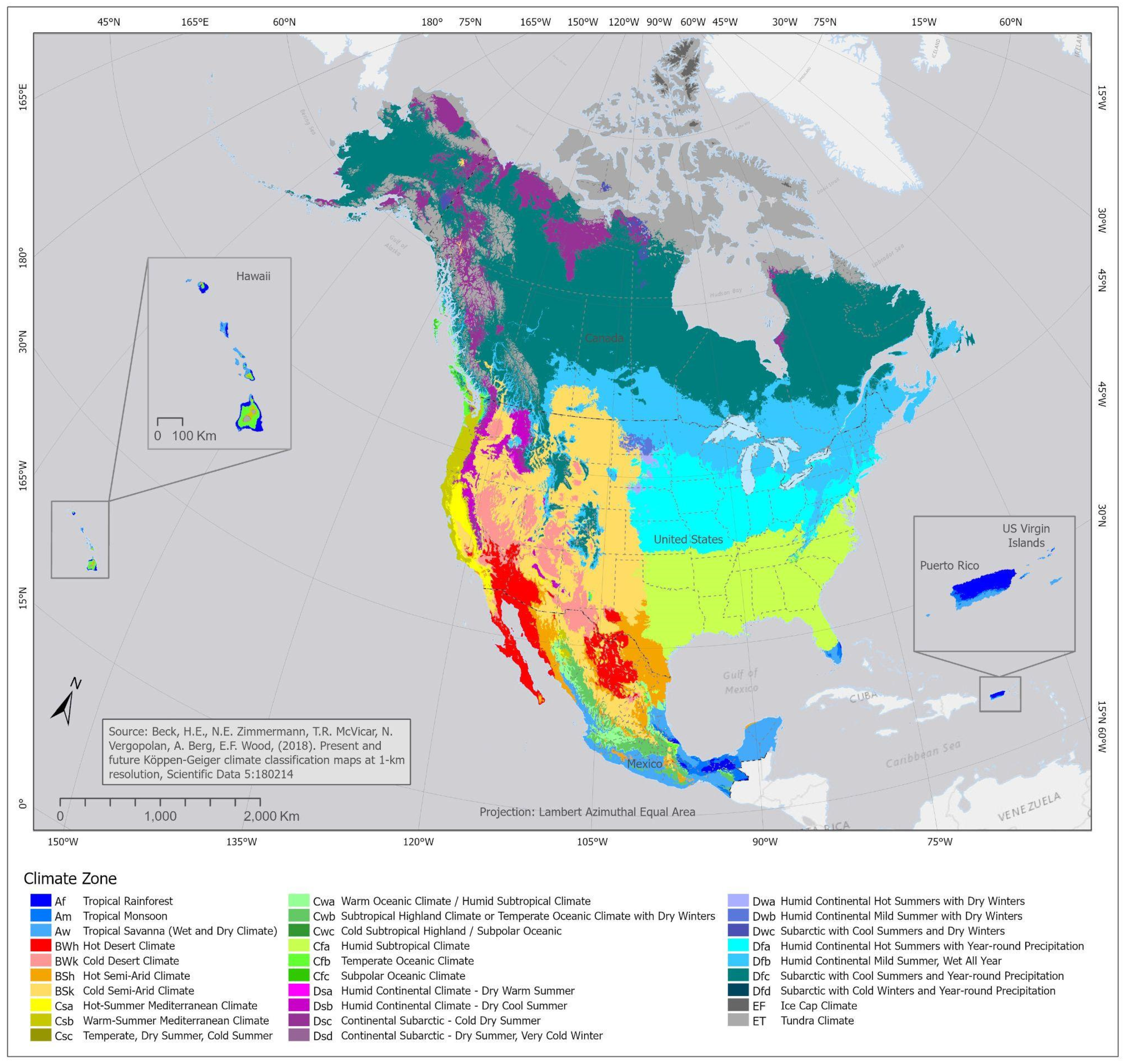
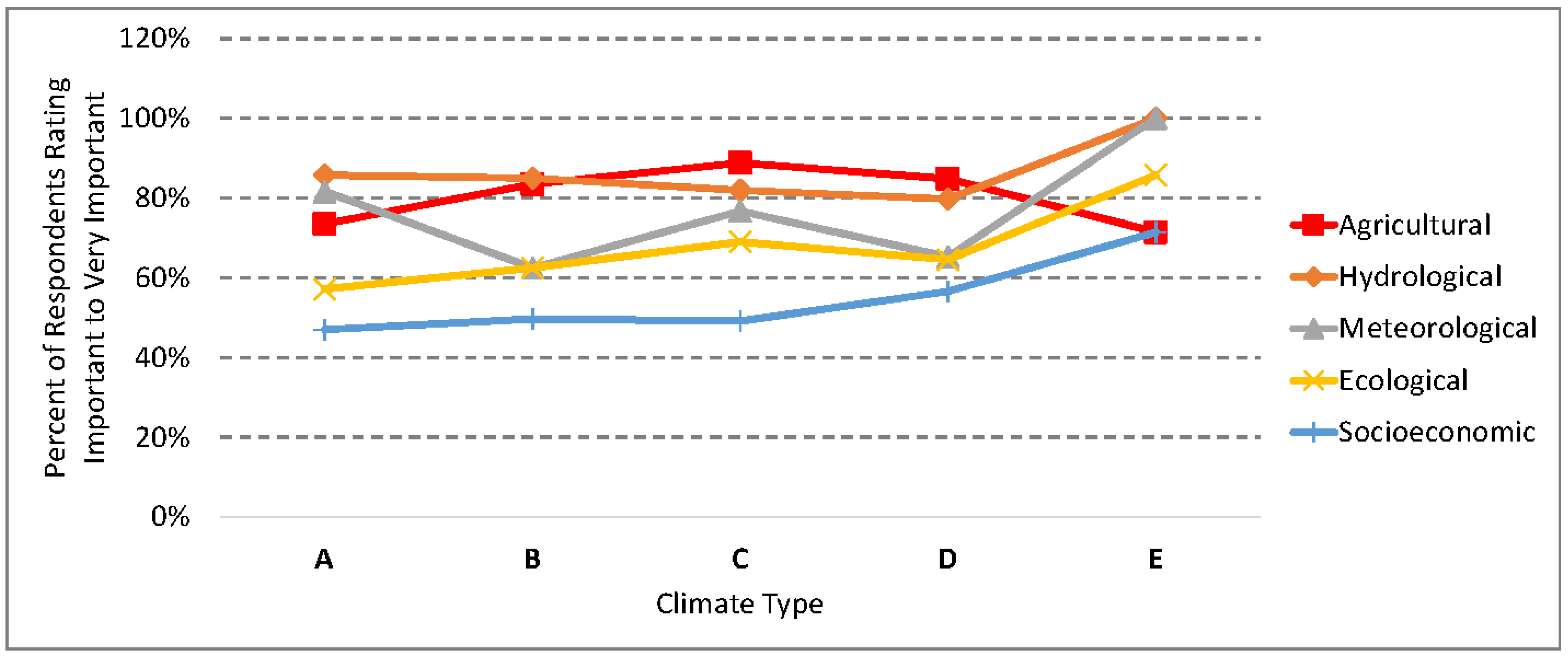
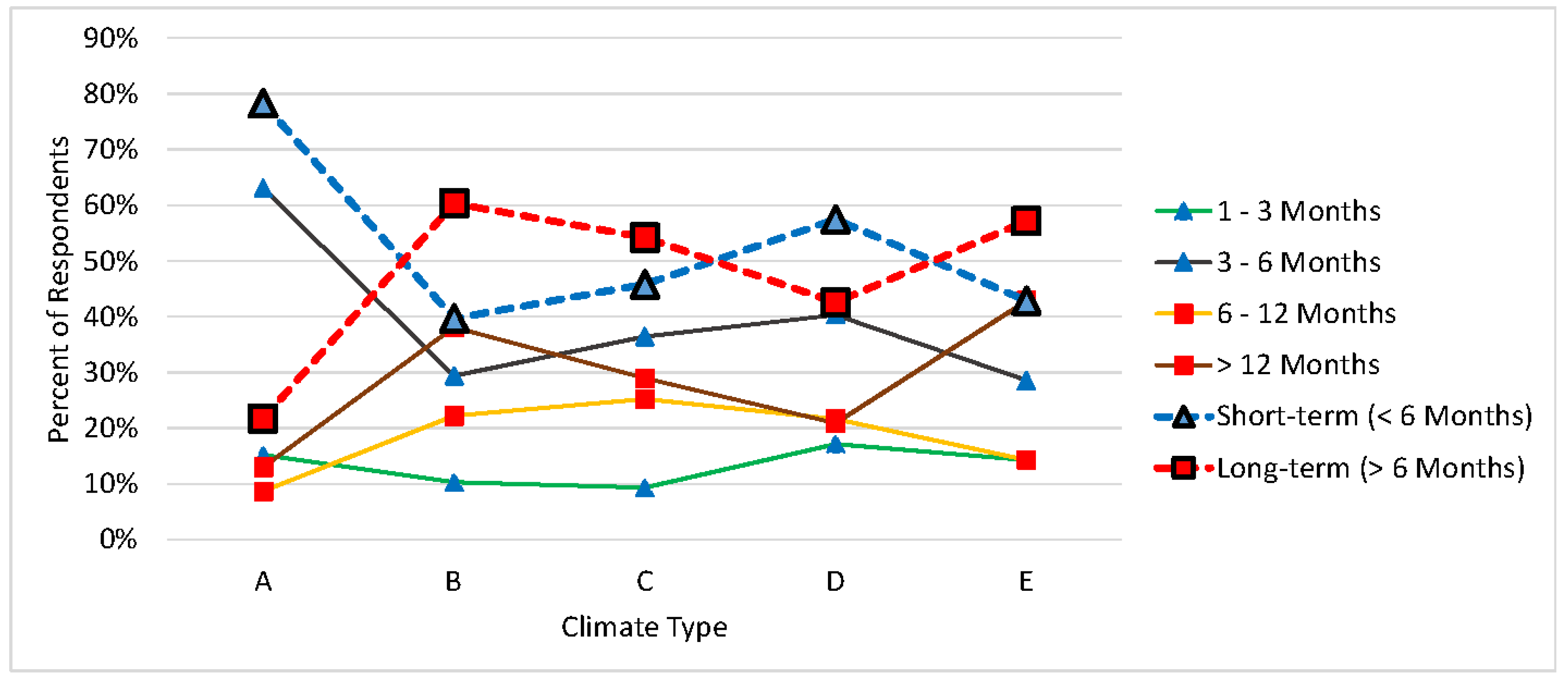
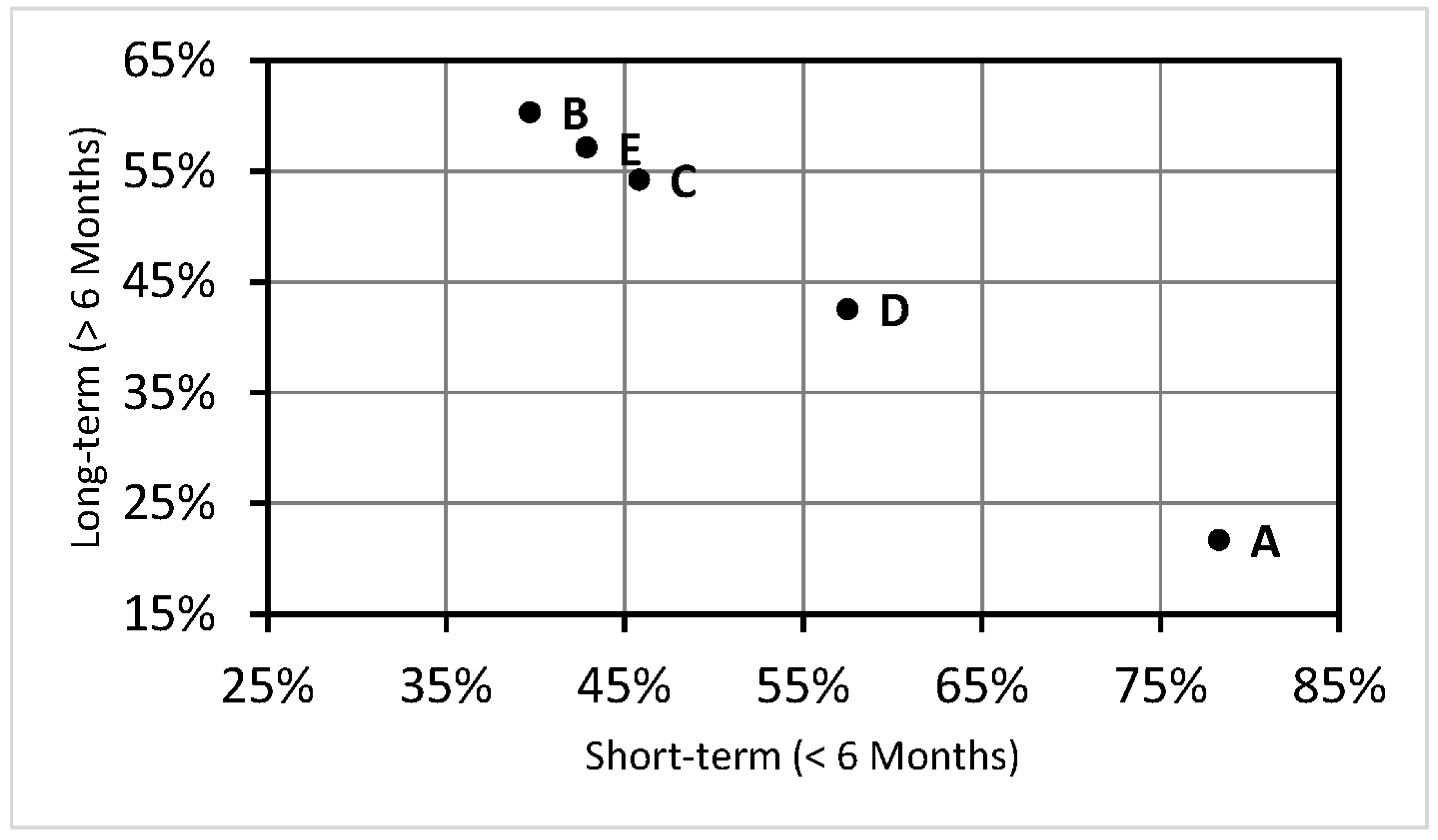
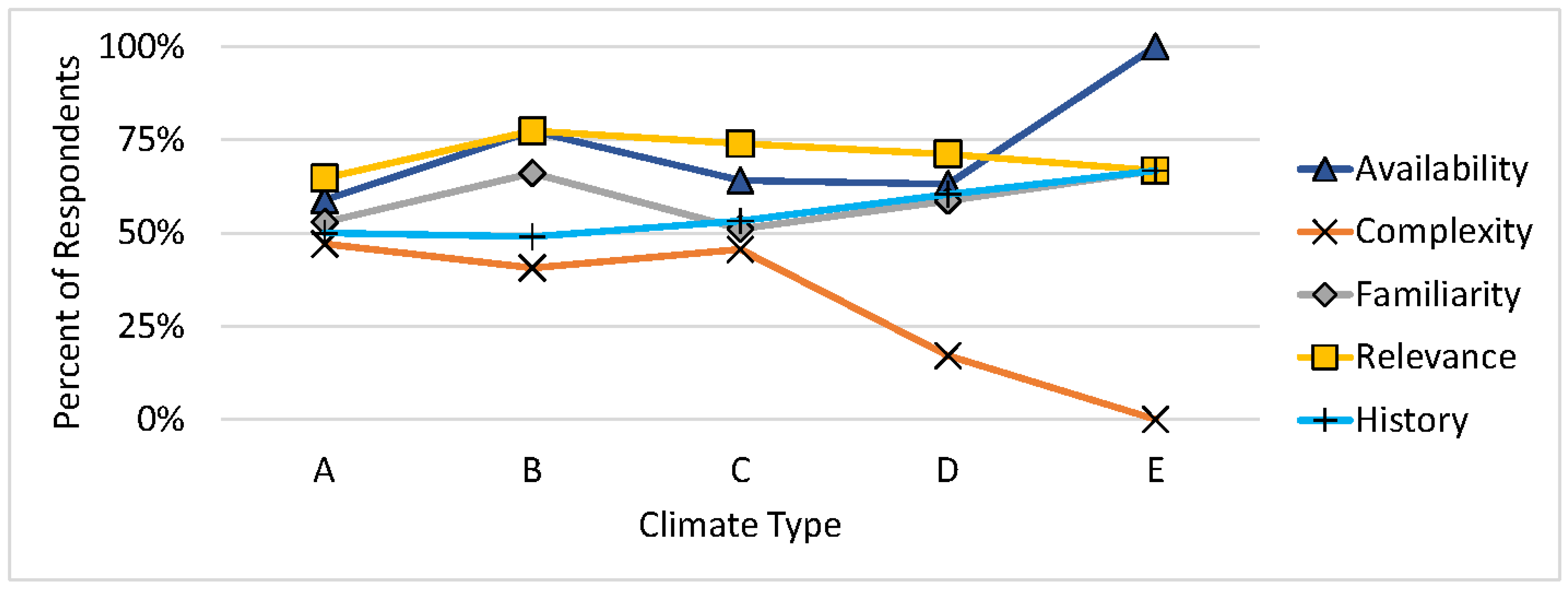
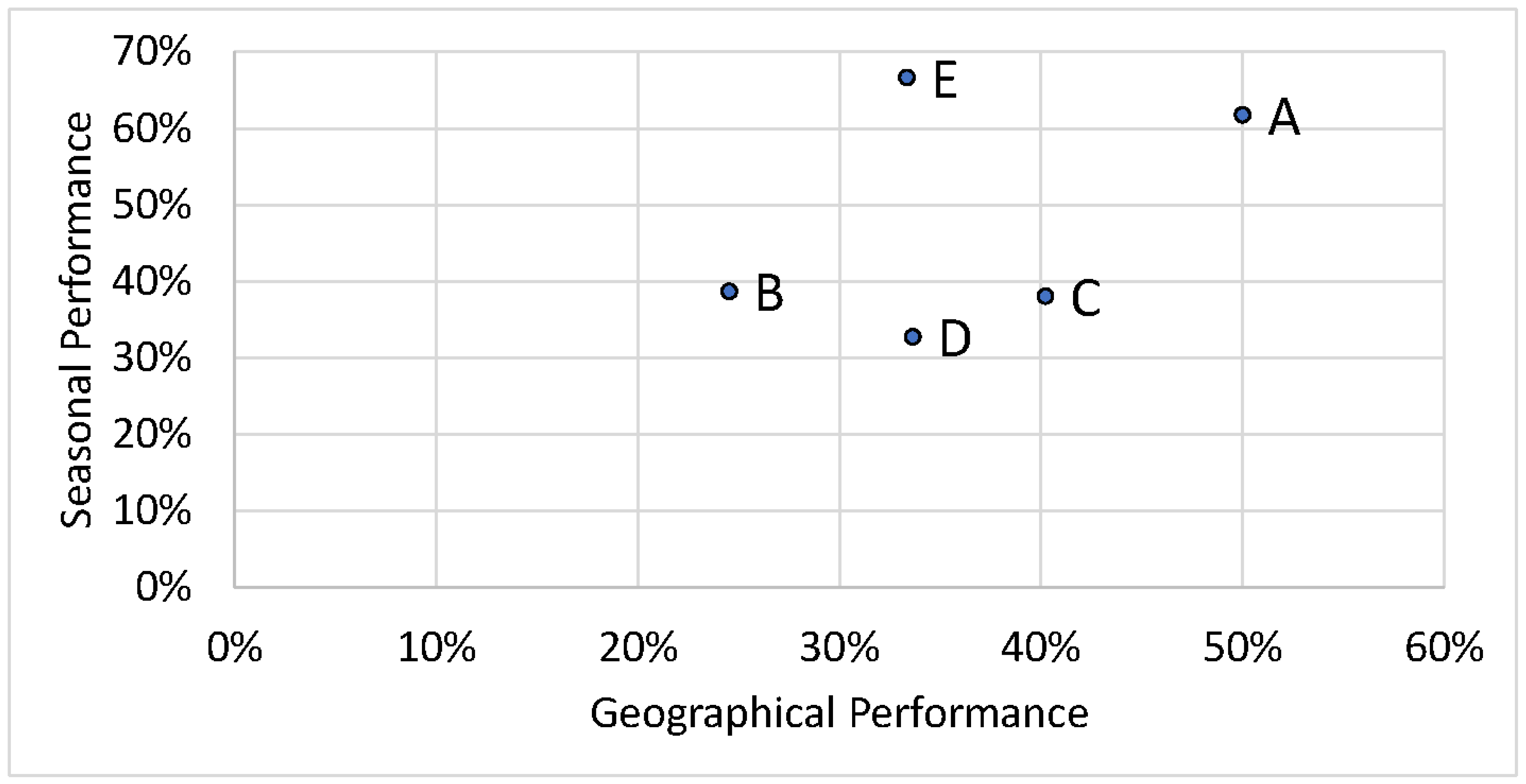
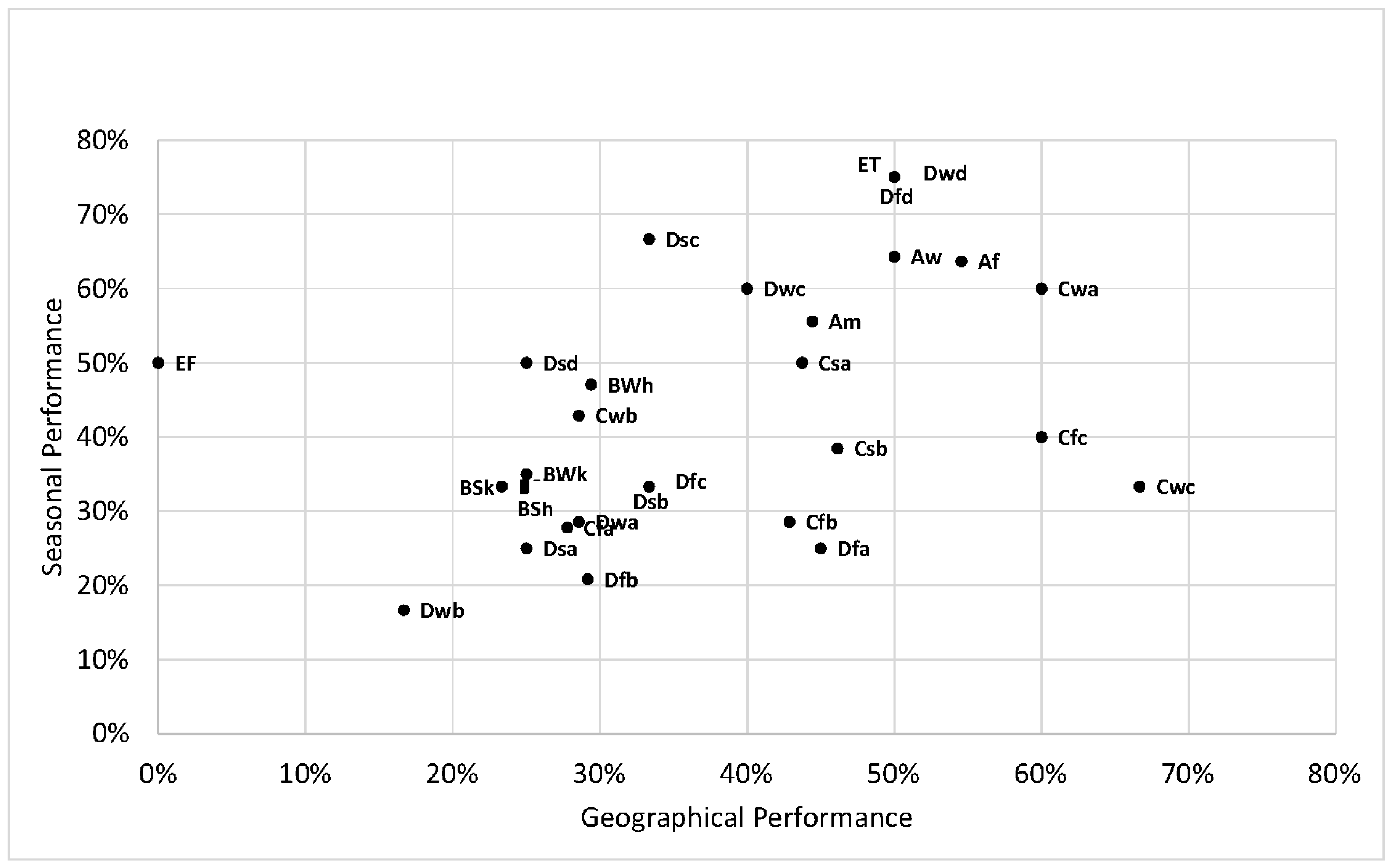
| Climate Zone | Drought Index or Indicator |
|---|---|
| A | SPI useful |
| SPEI useful in monsoon climates, but is more dependent on variation of precipitation than evapotranspiration | |
| PDSI can be useful | |
| EDI useful in monsoon climates | |
| B | SPEI useful, but is more dependent on evapotranspiration than precipitation |
| SPI and deciles/percentiles have difficulty for seasons/years with no precipitation | |
| SPI more useful during the wet season | |
| EDI useful | |
| CMI & NDVI from mid-June to mid-July for BS climates | |
| In BW climates, soil moisture and hydrological drought indicators should not be used | |
| C | PDSI can be useful; SPI more useful than PDSI; and SPEI more useful than SPI, especially in summer |
| SPI and deciles/percentiles have difficulty for seasons/years with no precipitation | |
| SPI and SPEI time scales of 1 to 3 months are relevant for agricultural applications and longer time scales (e.g., 6 to 12 months) for hydrological applications | |
| ESI effective in detecting rapidly-evolving agricultural drought situations | |
| Soil moisture indices and Palmer Z Index are effective for monitoring agricultural drought | |
| EDI useful | |
| D | SPI and deciles/percentiles have difficulty for seasons/years with no precipitation |
| SPI more useful during the wet season | |
| SPEI more useful than SPI, especially in summer | |
| SPEI less useful during winter in cold climates | |
| PDSI can be useful in mid-latitude D climates | |
| Vegetative Health Index (VHI) should be used with caution in cold climates and in winter | |
| ESI effective in detecting rapidly-evolving agricultural drought situations | |
| Soil moisture indices and Palmer Z Index are effective for monitoring agricultural drought | |
| E | VHI should be used with caution |
| SPEI less useful in E climates than other climates | |
| Streamflow and soil moisture drought indicators face difficulties in EF climates |
Disclaimer/Publisher’s Note: The statements, opinions and data contained in all publications are solely those of the individual author(s) and contributor(s) and not of MDPI and/or the editor(s). MDPI and/or the editor(s) disclaim responsibility for any injury to people or property resulting from any ideas, methods, instructions or products referred to in the content. |
© 2023 by the authors. Licensee MDPI, Basel, Switzerland. This article is an open access article distributed under the terms and conditions of the Creative Commons Attribution (CC BY) license (http://creativecommons.org/licenses/by/4.0/).





